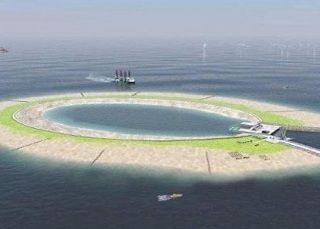Unique Approach to Pumped Hydro Energy Storage
My friends at Eos Energy Systems tell me that far more than 95% of the world’s energy storage is pumped storage hydroelectricity (PSH) – which is one of the reasons they believe that their breakthrough in zinc-air batteries is so important. We commonly think of PSH of requiring natural changes in elevation, since the cost of building such topographies would be cost-prohibitive – but is that necessarily true?
Here’s a unique approach to energy storage that the Belgians are implementing, building a hollowed-out island (pictured at left) off the coast of West Flanders, enabling them to more than triple their wind capacity (currently 3%) from its North Sea wind farms alone, allowing them to replace one of their two 3,000-MW nuclear plants.
The article doesn’t quote the cost, but this does seem potentially viable in shallow and calm waters.


Although this would in theory be possible, it is unlikely to be practical.
The head would vary with the tides. At low tide, the head would be reduced and vice versa. That would cause the effective amount of stored energy to vary significantly. Also, the volume of water required to store a given amount of energy would be much higher with lower heads and, in addition, the turbine size required would be much higher with lower heads. Having high heads would be very expensive. It’s also unclear why having such a system in the ocean would have any advantages of having such a system next to a lake. Considering that open pit mines can be excavated to considerable depths, it would probably be more economical to create something similar to an open pit mine on dry land next to a lake and use that instead. That would also reduce the complications of dealing with corrosive salt water.
Although pumped storage can work very well given appropriate geography, without appropriate geography the cost would be astronomical making it politically impossible.
I have often thought that it might be worthwhile to take advantage of mountain top removal for coal mining by hollowing out these mountain tops for pumped storage.
One of the big complaints I have heard about this procedure is the tendency of the mining companies to simply dump the removed material from the mountain top down the side of the mountain into the valley below which tends to pollute the water supply in the form of rivers and streams that run in the valleys. This means there is water available. If the removed material were to be more thoughtfully placed at the bottom of the mountain in the form of a reservoir and the top of the mountain left hollow in the form of a reservoir then all that would be needed is pumps and pipes. If the pump motors were to be permanent magnet types like stepper motors they could also be used for generation in the other direction. If the pumps themselves were to be positive displacement pumps like the oil pumps in cars then there would be less loss in both directions. Wind turbines are already being placed on these mountain tops so renewable energy power for the system would be readily available.
In total I envision hollowed out mountain tops with wind turbines placed around the ridge and pipes running down the mountain side to reservoirs made of the removed mountain material using positive displacement pumps driving and being driven by permanent magnet stepper type motors.
While I am not In favor of this type of mining, if it is going to be done anyway, might as well make best use of it. After all, a fair portion of the work is being done just in the mining process alone. The places where this is taking place also happen to be very good wind zones.
That sounds like something worth considering.
Actually, there are water turbines which work well in either direction and which are reasonably efficient. Induction motors can be used as asynchronous generators. Pumped storage systems have been built using turbines and motor – asynchronous generators. The only problem with asynchronous generators is that they can provide power only to a capacitive load, i.e., a load with a leading power factor, but that problem has been solved.
It’s just an idea I keep tossing around in my mind to take an advantage of an existing situation. It may be more efficient and cost effective to spend the capital on separate dedicated pumps and turbine generators. I don’t know. But the rest should work either way.
About 15 years ago, when I lived in San Diego, I became aware of a proposal to instal a pumped storage system in the mountains. The terrain was almost ideal for the project. The proposal included a unit that would work in both directions. It consisted of a device that could work as either a pump a turbine, and a motor that could also work as an asynchronous generator. Having a unit that could work in both directions reduced the capital investment. I don’t remember the efficiency, but I seem to recall that it was well above 80% per cycle.
The purpose of the proposal was to level demand because demand was far greater during the day than at night. It would have eliminated the need to build another power plant.
Efficient and economical storage is helpful regardless of the source of power.